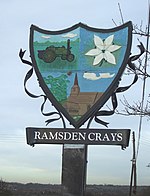Dale Farm

Dale Farm is a plot of land situated on Oak Lane in Crays Hill, Essex, United Kingdom. Until October 2011, it was the site of one of the largest Traveller concentrations in the UK, at its height housing over 1,000 people, along with the adjacent Oak Land site. Although Basildon District Council had granted permission for the site to be used by a small number of Traveller families, no planning permission was given for the expansion of the site into land located within the Green Belt.The establishment of the illegal plots led to Basildon District Council conducting a ten-year legal battle in the High Court to gain a clearance order to evict the Travellers from Dale Farm. The decision to bring in police officers to remove some activists and residents from the site and give safe access to the contracted bailiffs gained international press coverage, with the overall eviction costing the council £4.8 million.
Excerpt from the Wikipedia article Dale Farm (License: CC BY-SA 3.0, Authors, Images).Dale Farm
Oak Lane, Essex
Geographical coordinates (GPS) Address Nearby Places Show on map
Geographical coordinates (GPS)
| Latitude | Longitude |
|---|---|
| N 51.595 ° | E 0.474 ° |
Address
Oak Lane
Oak Lane
CM11 2YH Essex, Ramsden Crays
England, United Kingdom
Open on Google Maps






